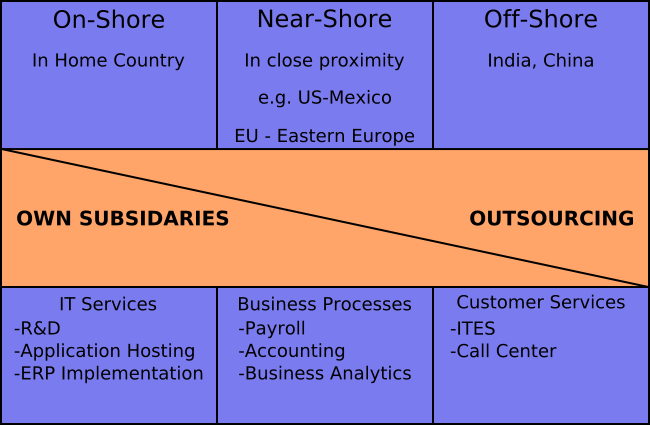- Distributed development
-
A distributed development project is a research & development project that is done across many business worksites or locations. It is a form of R&D where the project members may not see each other face to face, but they are all working collaboratively toward the outcome of the project. Often this is done through email, the Internet and other forms of quick long-distance communication.
It is different from outsourcing because all of the organizations are working together on an equal level, instead of one organization subcontracting the work to another.
It also is similar to, but different from, a virtual team because there is a research element.
Contents
Characteristics of distributed development
Location
People are distributed across multiple locations and work on the same project or product. The reasons for the distributions do not matter, they might include the availability of resources in different locations, closeness to certain clusters, proximity to customers or cost advantages. Examples could be the production of an Airbus or Boeing aircraft - those are usually done in multiple locations (though by the same company) and assembled finally in one location.
Collaboration
People might specialize in a distributed development environment, but they actively collaborate together to achieve the common goal. There must be a program lead or project manager somewhere in the project management mix. In a distributed environment, project members share ideas, information and resources. To get back to the Aircraft example; the Airbus engineers in Hamburg know exactly what their colleagues in Toulouse are doing and they know this well beyond just the interfaces of the pieces they do.
Responsibility and accountability
Everybody feels responsible for the achievement of the overall project goal. Nobody can succeed without everybody else being successful. This is also different from a typical outsourcing project, where every outsourced function just concentrates on (and gets measured against) the actual goals and tasks of that function. This mandatory set-up makes people think about what the "other side" thinks and makes them collaborate and help each other. Again, Airbus in Hamburg can never be successful if the aircraft does not take off. Even if they produce the best fuselage and wings the world has ever seen - the plane is only a success if it flies when assembled.

In summary, distributed development is one of the highest forms of collaboration in any engineering and R&D environment. It is difficult to achieve, since it requires high management capabilities, an excellent communication environment, a politically free environment, a highly efficient infrastructure, a well-developed organization chart, and frequent interaction. Most important, management needs to believe in the set-up and put measures in place to reward compliance, as well as be very strict with those who do not comply.
Success factors
There are three main success factors for a distributed development project:
- Select and/or recruit good, strong, highly skilled people.
- Spend some money for face-to-face meetings, especially at the beginning of each major project.
- Build an organizational design that supports working in a distributed development, including the right incentive systems.
By doing these three actions, one may obtain advantages beyond pure outsourcing or offshoring, namely much higher motivated employees in all parts of the distributed network, higher retention and certainly one gains from the diversity of the network.
The image below tries to explain how the different pieces fit together. There is a distinction between on-shore, near-shore and off shore and all three can be done either outsources (means by another company) or by owns subsidiaries. In all cases there are different levels of work done outside of the own local boundaries, ranging from simple service to high-end R&D.
Categories:- Management
- Organizational studies and human resource management
- Information technology management
Wikimedia Foundation. 2010.

